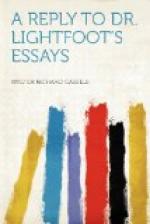“It will be remembered that Victor, Bishop of Capua, in the year 543, found a Latin Harmony or compilation of the four Gospels without any name or title, and being a man of enquiring mind he at once set about the task of discovering its unknown author. I have already mentioned the way in which, from the passage of Eusebius, he was led to ascribe his discovery to Tatian. This conclusion was generally traversed by Church writers, and Victor was supposed to have made a mistake. He is now, however, proved to have been a better judge than his critics, for, as Dr. Wace was the first to point out, a comparison of this Latin Harmony with the Ephraem fragments demonstrates their substantial identity, as they preserve to a wonderful degree the same order, and generally proceed pari passu.” [153:3]
But how about Luke i. 1 as the beginning? and the genealogies? Nothing could more clearly show the uncertainty which must always prevail about such works. Shall we one day discover that Victor was equally right about the reading Diapente?
I have thought it worth while to go into all this with a view of showing how little we know of the Diatessaron of Tatian and, I may add, of the Commentary of Ephraem Syrus and the work on which it is based. It is not at present necessary to examine more closely the text of either of the recently published works, but, whilst leaving them to be tried by time, I may clearly state what the effect on my argument would be on the assumption made by Dr. Lightfoot that we have actually recovered the Diatessaron of Tatian, and that it is composed upon a text more or less corresponding with our four Gospels. Neither in the “Harmony” itself nor in the supposed Commentary of Ephraem Syrus is the name of any of the Evangelists mentioned, and much less is there any information given as to their personality, character, or trustworthiness. If these works were, therefore, the veritable Diatessaron of Tatian and the Commentary of Ephraem upon it, the Gospels would not be rendered more credible as the record of miracles nor as witnesses for the reality of Divine Revelation.
* * * * *
It may not be uninstructive if I take the liberty of quoting here some arguments of Dr. Lightfoot regarding the authenticity of the “Letter of the Smyrnaens,” giving an account of the martyrdom of Polycarp. [154:1]
“The miraculous element has also been urged in some quarters as an objection to the genuineness of the document. Yet, considering all the circumstances of the case, we have more occasion to be surprised at the comparative absence than at the special prominence of the supernatural in the narrative. Compared with records of early Christian martyrs, or with biographies of mediaeval saints, or with notices of religious heroes at any great crisis, even in the more recent history of the Church—as, for instance, the rise




